What Happens In Vegas

What happens in Vegas stays in Vegas. Everyone knows this famous phrase. I have recently learned that some Scrum teams are applying this famous rule to their sprint retrospectives. In short, what happens in the sprint retro stays in the sprint retro.
The Vegas rule aims to establish a protected space for open and honest discussion within the Scrum team during Sprint Retrospectives. This rule encourages team members to freely express their thoughts and concerns without fear of information being shared outside the team. The intent is to foster trust and psychological safety, which enables the team to identify areas for improvement and continuously enhance their processes.
Unfortunately, everyone knows that the reality of the Vegas rule is that what happens in Vegas is streamed on YouTube. The airline pilots will even announce this when you land at Harry Reid International Airport. Applying this rule to sprint retros also runs counter to the spirit of Scrum where transparency and empiricism. Scrum relies on frequent inspection and adaptation. Teams make decisions based on what is known, not on what is assumed. Scrum also encourages close cooperation among all stakeholders. I am not a big fan of using the Vegas rule in sprint retrospectives. Scrum teams should foster an environment that encourages open communcations. Granted, not sprint outcome is successful. Things happen. Setbacks happen. Use the identify to identify the root cause and learn from it. There should be data or facts to support your conclusions. Be transparent about what happened and how you will correct for it going forward. If you really do need secrecy in your retros, then you're either working on a secret project or you have an HR event brewing.
Are you using the Vegas rule in your sprint retros? How is the team deciding what is public and what is private?
